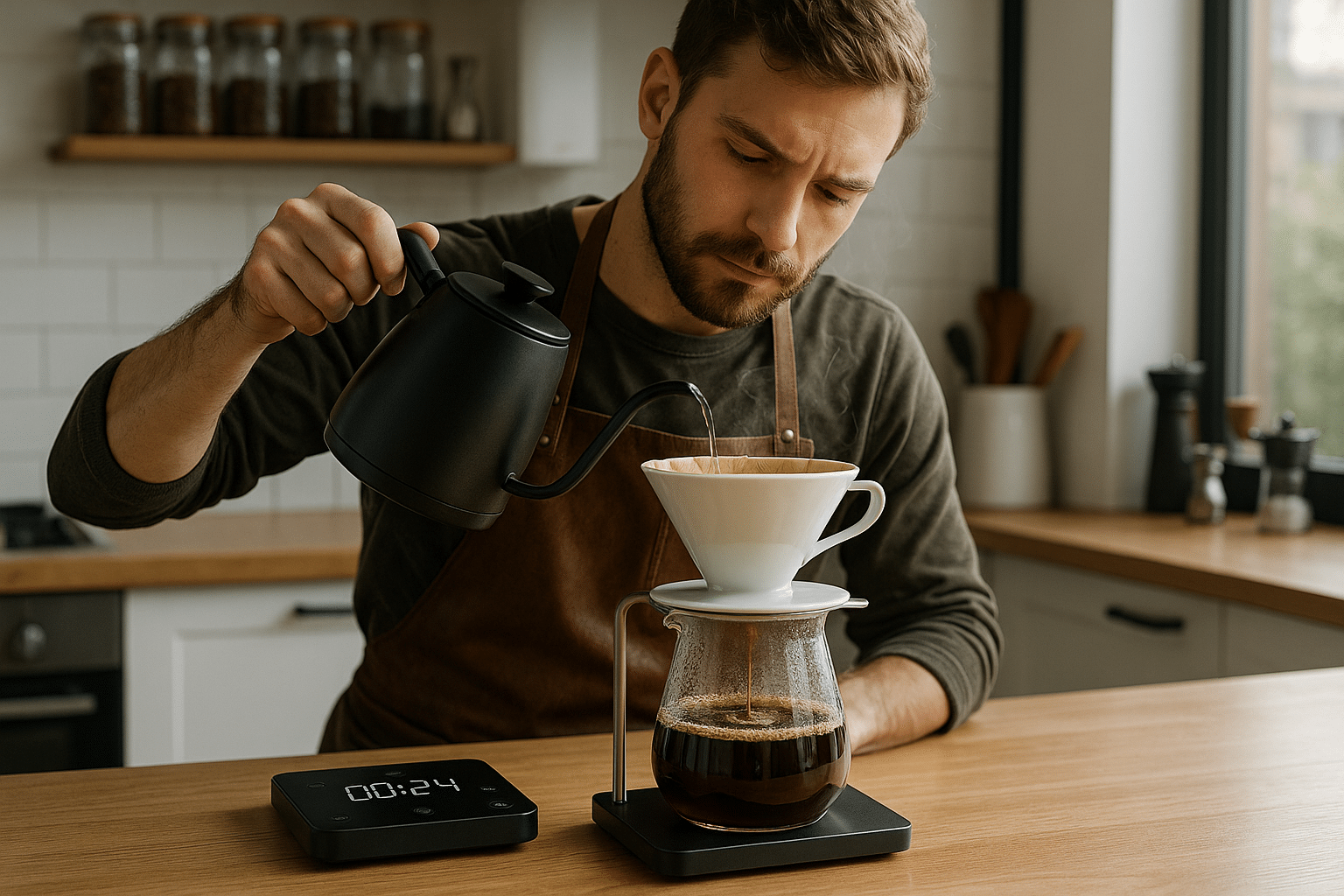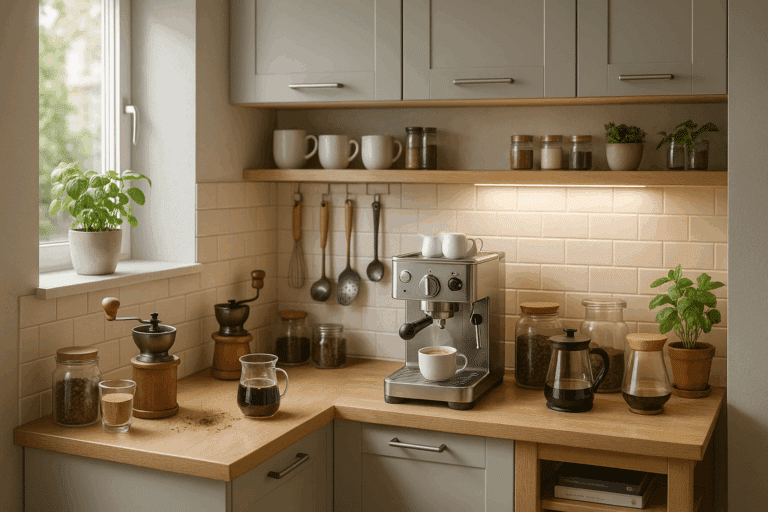For many, brewing a perfect cup of coffee is no less than a scientific endeavor – an art form to be revered. Understanding the right temperature, the ideal coffee-to-water ratio, and most crucially, the perfect pour-over timing is an intimate ritual. In this comprehensive guide, we unravel the complexities of the pour-over technique, transforming it from an intimidating mystery to a mastered skill you can proudly own.
☕ Are you ready to embark on a journey to elevate your coffee brewing experience?
Firstly, let’s demystify what pour-over coffee is. It’s a hands-on brewing method that, despite the simplicity of its concept, requires precision and care. The basic tenet lies in manually pouring hot water over coffee grounds in a filter. The water drains through the coffee into a carafe or cup, delivering a brew that is clean, vibrant, and fulfilling.
The beautiful dance of water and coffee in a pour-over brew isn’t simply a means to an end; it’s a meditative practice that offers an intimate interaction with your coffee. The technique allows you to control every variable, offering a coffee experience that is both personalized and rewarding. 🌟
But what if your pour-over could be better? What if you’ve been missing out on achieving the ultimate coffee experience due to one small yet influential factor – timing?
Timing is everything in pour-over brewing. It can be the difference between a balanced cup and one that’s too bitter or weak. But don’t fret; we’re here to guide you through the process, helping you perfect your pour-over timing. Not only will this enhance the flavors of your brew, but it will also make your daily coffee ritual even more enjoyable.
💡 We’ll dive into understanding the four critical stages of pour-over brewing – the Bloom, the First Pour, the Second Pour, and the Drawdown. Each stage has a unique role and requires careful attention to time. From the initial contact of water with the grounds, through the dynamic process of extraction, to the final drawdown, timing guides the coffee’s journey. Our deep dive into these stages will provide you with the know-how to yield a perfect brew every time.
We’ll also explore the art of ‘pulse pouring’ and its pivotal role in the pour-over brewing process. You’ll learn how to adjust your pouring technique to manipulate brew strength and flavor profile, bringing forth the best characteristics of your chosen coffee beans.
Ready to embrace the art of pour-over coffee brewing and transform your coffee routine? Let’s journey together into the science and finesse of pour-over timing. This ultimate guide is designed to provide you with everything you need to perfect your pour-over game, making every sip a testament to your newfound mastery. 🏆
Remember, great coffee isn’t an accident; it’s a result of understanding, precision, and passion. So, let’s dive in and demystify the art of pour-over brewing. Sit back, relax, and prepare to master a skill that will truly elevate your coffee experience.
Let’s start brewing!
Embrace the Brewing Process: Understanding the Core Concepts of Pour-Over
When it comes to the art of brewing coffee, the pour-over method has been celebrated by coffee aficionados for its clean, complex flavors and the control it provides over every variable in the brewing process. This hands-on approach enables you to fine-tune your coffee to your exact taste. If you’re serious about mastering pour-over coffee, the first step is understanding the core concepts that underpin this method.
Three critical elements play a vital role in the pour-over brewing process: the water temperature, the grind size, and the pouring technique. The water temperature should ideally be between 195-205 degrees Fahrenheit (90-96 degrees Celsius). This range is perfect for extracting the full flavor of the coffee without over-extracting or under-extracting the coffee grounds. The grind size should be medium-fine, like the consistency of sea salt. A consistent grind size ensures an even extraction, leading to a more balanced cup of coffee. The pouring technique involves pouring the water in a slow, steady stream over the coffee grounds, ensuring they are evenly saturated and extracting the most flavor possible.
Each of these variables can be adjusted according to personal preference, making pour-over a versatile method that can cater to a wide range of tastes. Whether you prefer your coffee strong and robust or light and delicate, mastering the pour-over method can help you brew the perfect cup every time.
Time is of the Essence: Perfecting Your Timing for the Ultimate Coffee Experience
A crucial aspect often overlooked by novice brewers is the importance of timing in the pour-over method. The length of time the water is in contact with the coffee grounds significantly affects the taste of the brew. Too long, and the coffee may be over-extracted, resulting in a bitter taste. Too short, and the coffee may be under-extracted, leading to a weak, sour flavor. The ideal brewing time for pour-over coffee is typically between 3 to 5 minutes.
To achieve this timing, the pour should be done in stages, starting with a small amount of water known as the ‘bloom’ pour. This initial pour should be about twice the weight of the coffee grounds and lasts for about 30 seconds. The bloom pour allows the coffee to release gases, leading to better extraction in the subsequent pours. The remaining water should be poured in a slow, steady stream, taking care to keep the water level consistent throughout the brewing process.
Mastering this timing requires practice, patience, and a good timer. Many coffee enthusiasts use a scale with a built-in timer for precision and consistency. With time and practice, you’ll be able to nail down the perfect pour-over timing that suits your taste.
Video Reference: “The Art of Pour Over Coffee” by Joe Bean Coffee Roasters
For a visual guide to perfecting your pour-over technique and timing, check out this informative video: “The Art of Pour Over Coffee” by Joe Bean Coffee Roasters. This video provides step-by-step instructions on the pour-over method, including tips on how to achieve the perfect timing.
Comparative Insights: Pour-Over vs. Other Brewing Methods
While pour-over is celebrated for its ability to produce a clean, flavorful cup of coffee, how does it compare to other popular brewing methods? Let’s delve into the unique characteristics and benefits of pour-over and how it stacks up against other brewing techniques.
| Method | Flavor | Control | Convenience |
|---|---|---|---|
| Pour-Over | Clean, complex flavors. Less bitterness and acidity than other methods. | High. Allows control over every variable in the brewing process. | Requires more time and attention than other methods. |
| Drip Coffee | Depends on the machine. Can produce a good cup, but may lack the depth and complexity of pour-over. | Medium. Some control over water temperature and brew time, depending on the machine. | High. Simply add water and coffee and let the machine do the work. |
| French Press | Rich, full-bodied flavor. More oils and sediment than pour-over, which can add bitterness. | Medium. Some control over brew time and water temperature. | Medium. Easy to use, but requires careful timing to avoid over-extraction. |
| Espresso | Intense, concentrated flavor. Can be bitter if not brewed correctly. | High. Allows control over grind size, water temperature, and pressure. | Low. Requires specialized equipment and skill to use effectively. |
As you can see, the pour-over method offers a unique combination of control and flavor that is hard to match with other brewing methods. While it may require more time and attention, the resulting cup of coffee is well worth the effort.
Final Thoughts
Mastering the art of pour-over is a journey of discovery and refinement. It requires patience, practice, and a willingness to experiment with different variables to find what works best for you. But once you’ve nailed down your technique, you’ll be rewarded with a truly exceptional cup of coffee. So, why not start your pour-over journey today?
Remember to keep refining your technique, pay attention to details, and, most importantly, enjoy the process. Happy brewing! ☕️

Conclusion
In summary, we’ve explored the depths of complex concepts in the realm of IT and engineering, consolidating these intricate notions into digestible segments for all readers to understand. Whether you’re a seasoned professional or an interested novice, I trust that this article has provided a clear, comprehensive insight into these technical topics, serving as a reliable resource for your ongoing learning.
Throughout the article, we dived into the intricate layers of software engineering and the impacts it has on today’s technological advancements. We broke down the significance of software architecture, the role it plays in structuring the system, managing complexity, and enhancing performance, security, and maintainability. Also, we highlighted the importance of design principles in writing robust, maintainable and reusable code.
Additionally, we examined the process of requirement engineering, which is fundamental in the lifecycle of software development. It is a method of defining, documenting, and maintaining software requirements in a systematic and controlled manner, leading to successful project outcomes.
We further discussed the importance of testing, debugging, and maintenance. These are crucial components of the software development process that help ensure the reliability, performance, and long-term viability of the software.
Finally, we touched on the importance of project management in IT and engineering. Through effective planning, organizing, and controlling resources, project managers can successfully guide their teams to meet project objectives and deliver high-quality outputs.
As we delve deeper into the digital age, the importance of understanding these concepts continues to grow. The technical language and complex ideas that surround the field of IT and engineering need not be a barrier for anyone seeking to gain insight or develop their professional skills.
Your comments, shares, and applications of the information presented here are highly appreciated. They not only validate the relevance of this article, but they also help to foster an environment of shared learning and growth.
Please take the time to check out additional resources linked throughout the article. There is a wealth of knowledge waiting for you in our interconnected digital world. Please also ensure to keep abreast with our updates as we continue to explore the fascinating world of IT and engineering. 🌐💻👨💻
And remember, continuous learning is the minimum requirement for success in any field. This is particularly true in IT and engineering where innovation and change are constants.
I encourage you to keep reading, keep exploring, and keep pushing the boundaries of what you know. As Albert Einstein famously said, “The more I learn, the more I realize how much I don’t know.” 🧠🌟🚀
References:
Software Engineering – Wikipedia
Software Architecture – Carnegie Mellon University
Software Requirements – TutorialsPoint
Project Management for Software Engineers – Project Management Institute



